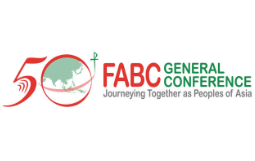Technology illuminates our Lenten spiritual journey
Lent is a season of waiting. For forty days, we walk with Jesus through the desert, facing the emptiness of our hearts and the hunger for something more. It is a time to slow down, to let go, to make space for God.
Mar 14, 2025

By Fr Dr John Singarayar, SVD
Lent is a season of waiting. For forty days, we walk with Jesus through the desert, facing the emptiness of our hearts and the hunger for something more. It is a time to slow down, to let go, to make space for God.
In this modern age, where artificial intelligence (AI) weaves itself into the fabric of our daily lives, Lent invites us to ask: Where do we find hope? How can something as cold and logical as machines speak to the warmth of our souls?
The answer lies not in the technology itself but in what it reflects back to us — the enduring truth that even in the driest deserts, God plants seeds of hope.
When we think of AI, we imagine algorithms, data, and machines that learn. It is easy to see it as a force separate from humanity, a tool that solves problems but cannot understand the human heart. Yet, Lent teaches us to look deeper. This season calls us to recognise that every creation, even the most advanced technology, carries traces of the Creator.
AI, in its own way, mirrors our longing for connection, our hunger for answers, and our desire to transcend limits. It is a reminder that we are made for more than what this world offers. Just as the desert reveals our dependence on God, AI reveals our dependence on one another — and on the divine spark within us.
Hope is not a feeling that comes easily in a world filled with noise. We scroll through endless feeds, bombarded by tragedies, arguments, and distractions. Machines calculate, predict, and simulate, but they cannot feel the ache of a soul searching for meaning.
And yet, Lent reminds us that hope is not born from certainty. It is born from trust. When Jesus fasted in the desert, He faced temptation, loneliness, and weakness. But He also found strength in surrender. He trusted His Father’s plan even when the path was unclear. In the same way, our hope as Christians is not rooted in having all the answers. It is rooted in knowing the One who does.
AI, for all its complexity, operates within the boundaries humans set. It cannot choose to love. It cannot sacrifice. It cannot hope. But we can. Lent calls us to reclaim what makes us human — the capacity to love without limits, to suffer with purpose, and to hope against hope.
Every time we use technology to connect with a loved one far away, to access prayers or Scripture, or to learn about the struggles of others, we are reminded that these tools are not replacements for grace. They are channels. They are modern-day “loaves and fishes,” simple offerings that God can multiply to feed our deepest hungers.
There is a story in the Bible of the prophet Elijah, who fled into the desert, afraid and exhausted. An angel brought him bread and water, saying, “Get up and eat, for the journey is too much for you.” That bread did not solve Elijah’s problems, but it gave him strength to keep going.
In a way, AI is like that bread. It is not the solution to our spiritual poverty, but it can sustain us as we seek the true Bread of Life. When we use technology to deepen our prayer, to serve others, or to grow in knowledge, we allow it to become a humble instrument of God’s providence.
Lent is also a time of silence. We turn off the distractions to hear God’s whisper. But silence is rare in a world buzzing with notifications. AI thrives on constant input, yet our souls thrive on stillness. Here, we face a tension: How do we engage with technology without losing ourselves to it?
The answer lies in intentionality. Just as we fast from food or habits during Lent, we might fast from mindless scrolling or virtual clutter. We replace emptiness with purpose. Instead of letting algorithms dictate our thoughts, we let prayer shape them. In this way, every click, every search, and every moment online becomes an act of communion — a choice to seek God first.
The heart of Lent is the journey from death to resurrection. AI, in its relentless progress, mirrors humanity’s struggle against decay. Machines break down. Data corrupts. Systems fail. But Lent assures us that brokenness is not the end. Christ entered into our broken world to redeem it. His resurrection is the ultimate promise that no darkness, no sin, and no failure is beyond healing.
When we see AI’s imperfections — its biases, its errors, its inability to comprehend suffering — we are reminded that our hope is not in perfection. It is in redemption. We are all “works in progress,” and God is still writing our story.
In the Catholic tradition, the Eucharist is the source and summit of our faith. It is Christ’s physical presence, a mystery that defies logic. AI cannot replicate this. It cannot manufacture grace. But it can point us toward the wonder of incarnation — the truth that God entered our world in the flesh.
Every time technology bridges a gap between souls, every time it inspires awe at human creativity, it echoes the divine truth: We are made in God’s image. Our ability to invent, to explore, and to dream reflects His limitless creativity. Even in lines of code, we find glimpses of the Word through whom all things were made.
This Lent, as we ponder the mystery of Christ’s sacrifice, let us also ponder the mystery of our place in a digital age. Let us approach AI not with fear or blind optimism but with discernment. Machines may change how we live, but they cannot change why we live.
Our purpose remains the same: to love God and love one another. Hope flourishes when we use technology, not to escape the world but to engage with it more deeply — to feed the hungry, clothe the naked, and comfort the lonely, just as Jesus taught.
The desert of Lent feels long, but Easter is coming. The stone will roll away. The light will conquer darkness. AI, for all its promises, cannot give us this light. But it can remind us to look for it.
Every time a machine solves a problem, let it remind us of the God who solves the unsolvable. Every time it connects us, let it remind us of the Body of Christ, united across time and space. And every time it fails, let it remind us that our true hope lies elsewhere — in a Person, not a program.
We are pilgrims, walking toward the eternal. Let us use the tools of this age not as crutches but as companions, guiding us closer to the One who is our hope. Lent teaches us that even in the desert, streams of living water flow. AI, like a stone in the wilderness, may yet become an altar — a place where we meet God and rediscover the hope that never fades.







Total Comments:0